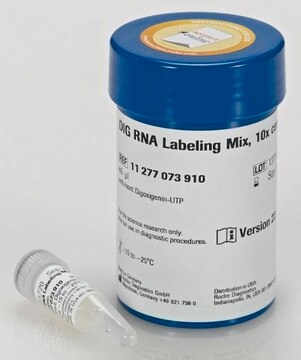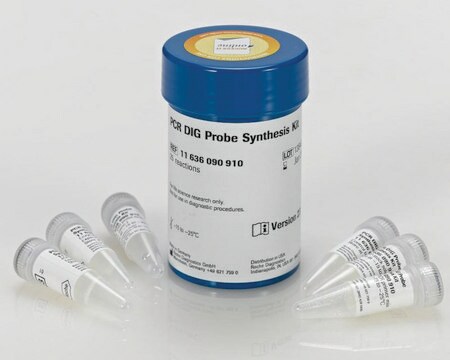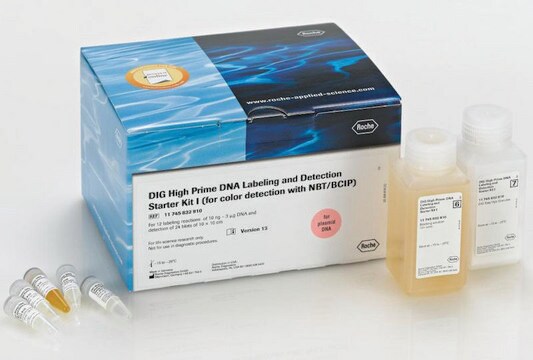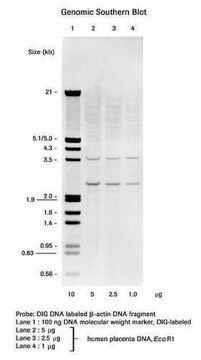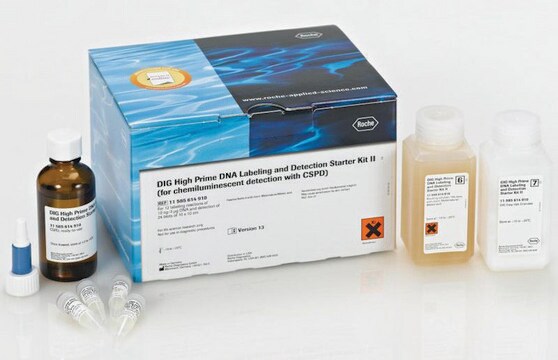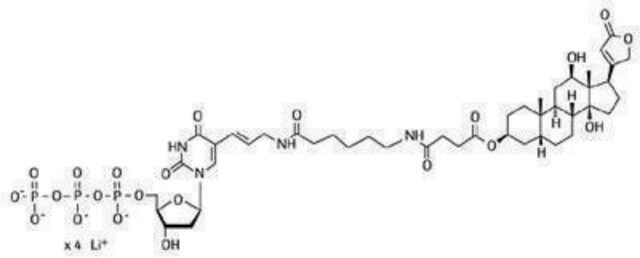11277065910
Roche
DIG DNA Labeling Mix
Synonyme(s) :
DNA labeling
About This Item
Produits recommandés
Forme
solution
Niveau de qualité
Utilisation
sufficient for 25 standard reactions
Conditionnement
pkg of 50 μL
Fabricant/nom de marque
Roche
Caractéristiques du produit alternatif plus écologique
Designing Safer Chemicals
Learn more about the Principles of Green Chemistry.
sustainability
Greener Alternative Product
Couleur
colorless
Solubilité
water: miscible
Autre catégorie plus écologique
Température de stockage
−20°C
Description générale
We are committed to bringing you Greener Alternative Products, which adhere to one or more of The 12 Principles of Greener Chemistry. This product is designed as a safer chemical. The DIG System was established as a sensitive and cost-effective alternative to radioactivity for the labeling and detection of nucleic acids. There are many available publications that prove the versatility of the DIG System, so use of radio-labeling is no longer the only option for labeling of DNA for hybridization.
Application
- Southern blots
- northern blots
- dot blots
- screening of gene libraries
- in situ hybridizations
Caractéristiques et avantages
10x concentrated dNTP labeling mixture: 1mM dATP, 1mM dCTP, 1mM dGTP, 0.65mM dTTP, 0.35mM DIG-dUTP, alkali-labile, pH 7.5 (+20°C)
Assay Time: Labeling: 1 hour to O/N
Labeling efficiency: With 1μg DNA per assay, approx. 10% of the nucleotides are incorporated into about 250ng of newly synthesized labeled DNA within 1 hour and approx. 30% of the nucleotides into about 750ng after 20 hours.
Qualité
Principe
Notes préparatoires
As template for the labeling reaction
- DNA fragments of at least 100bp
- Linearized plasmids, cosmid or λDNA,
- Supercoiled DNA,
- Or minimal amounts of DNA (10ng), e.g., DNA restriction fragments isolated from low melting point agarose can be used.
Note: Linear DNA is labeled more efficiently than circular and supercoiled DNA.
Autres remarques
Code de la classe de stockage
12 - Non Combustible Liquids
Classe de danger pour l'eau (WGK)
nwg
Point d'éclair (°F)
No data available
Point d'éclair (°C)
No data available
Faites votre choix parmi les versions les plus récentes :
Déjà en possession de ce produit ?
Retrouvez la documentation relative aux produits que vous avez récemment achetés dans la Bibliothèque de documents.
Les clients ont également consulté
Articles
Digoxigenin (DIG) labeling methods and kits for DNA and RNA DIG probes, random primed DNA labeling, nick translation labeling, 5’ and 3’ oligonucleotide end-labeling.
Notre équipe de scientifiques dispose d'une expérience dans tous les secteurs de la recherche, notamment en sciences de la vie, science des matériaux, synthèse chimique, chromatographie, analyse et dans de nombreux autres domaines..
Contacter notre Service technique

